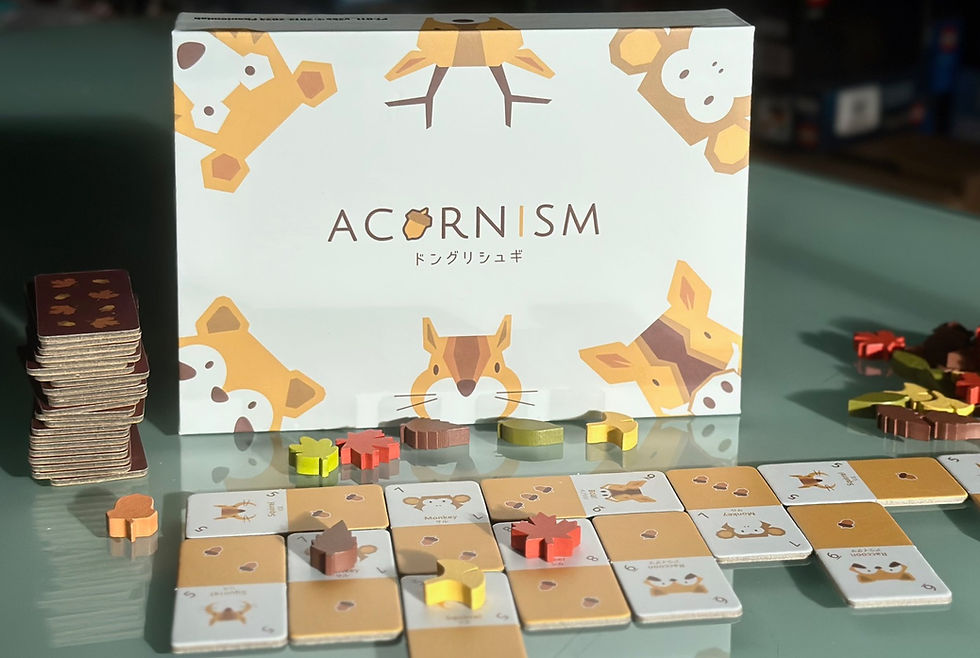Atelier: The Painter's Studio
- Selwyn Ward

- Aug 12, 2019
- 3 min read
Updated: Oct 24, 2020
Picture yourself as a 19th Century artist managing your atelier (studio/workshop). That's the setting for this beautifully produced game from AEG.

In Atelier, 2–4 players each roll four dice at the start of a round. The numbers you roll determine the specific actions you can take; for example, a 1 or 2 allows you to deploy one of your apprentices at the red, blue, green or yellow paint supply location. A die roll 4 lets you claim paint from all the locations where you have more apprentices than any of the other players. Your aim is to accumulate sufficient paint in the colours required to complete one of the paintings available in a central tableau. Once you have all the requisite paint, you need a die roll 5 to 'paint' the picture and claim it. When you do, it'll be worth end-game points and most paintings will also give you a special ability that will help you complete future paintings.
Inevitably in a game where you are rolling dice to determine actions, there's a luck quotient in Atelier but all of the available actions are potentially desirable. We initially feared that a fortuitous roll could give the first player a big advantage. For example, a roll of three 1s or 2s, and one 4, would likely give the player a majority in three paint locations and would allow them immediately to collect three different colour paints; which would not be duplicable by the second player with an identical roll (their apprentice placements wouldn't deliver three majorities so they'd not collect three paints). We found, however, that subsequent players could nonetheless do well from their rolls. And, on the off-chance that you have a die roll you can't use productively, you always have the option of spending any die to buy an 'inspiration token'. These can be used in various ways including (for 2 tokens) to take a paint a picture action without a die roll 5, and (for 3 tokens) to pick an extra Patron card in addition to the Patron everyone starts with. These cards are kept concealed from other players and give opportunities for scoring bonuses, so having more Patrons can significantly boost your end-game score.
You can always rely on AEG to go the extra mile over the presentation and production of their games, and that's certainly the case with Atelier. No matter that the wooden paint cylinders look more like the paint pots you'd buy to decorate a room than the oils you'd daub on canvas to create a masterpiece :-) The paintings are all classic 19th Century Impressionist, Post-Impressionist, Realist or Romantic works; beautifully reproduced on 70 x 120mm cards: so this is a game where the art credits include Edouard Manet, JMW Turner and Vincent Van Gogh! The player boards don't serve any important function and could have been dispensed with altogether, but AEG have nonetheless gone to town with them so that they look like artists' palettes. The visual appeal of this game is bound to be a key factor in its draw: you don't have to be a dedicated gamer to want to sit down and play this game. And, crucially, you don't need to be an experienced gamer to play because Atelier is a very accessible 'gateway' game. It's an excellent way of introducing people to much more complex dice and worker placement games.
Tho' it's very accessible, that doesn't mean Atelier lacks depth. There's strategy in selecting paintings to paint that maximise your Patron bonus and that can be used in combo to complete other paintings. There are tactics too in the way in which you deploy and move apprentices at the four paint locations. In effect, this combines elements of worker placement with area control. It's the one part of the game where there can be a bit of 'take that' interaction, as the judicious use of the move action (die roll 3) can be used to deprive an opponent of a majority and therefore the opportunity to benefit from a collect paint action.
Atelier plays quickly: you can expect to complete a four-player game in no more than 45 minutes and you can finish a two-player game in less than 30 minutes. This is a game that has the potential to achieve a mass market appeal. Could it be the next Ticket to Ride? If it succeeds, Board's Eye View will be looking forward to some Pre-Raphaelites in the inevitable Atelier expansion. :-)
(Review by Selwyn Ward)




